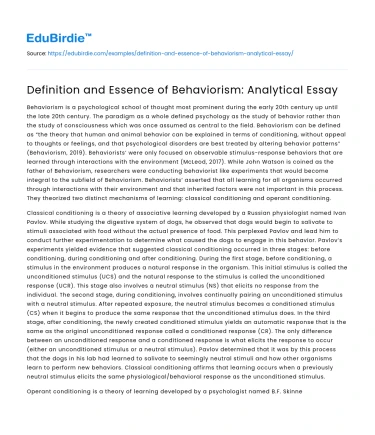Behaviorism is a psychological school of thought most prominent during the early 20th century up until the late 20th century. The paradigm as a whole defined psychology as the study of behavior rather than the study of consciousness which was once assumed as central to the field. Behaviorism can be defined as “the theory that human and animal behavior can be explained in terms of conditioning, without appeal to thoughts or feelings, and that psychological disorders are best treated by altering behavior patterns” (Behaviorism, 2019). Behaviorists’ were only focused on observable stimulus-response behaviors that are learned through interactions with the environment (McLeod, 2017). While John Watson is coined as the father of Behaviorism, researchers were conducting behaviorist like experiments that would become integral to the subfield of Behaviorism. Behaviorists’ asserted that all learning for all organisms occurred through interactions with their environment and that inherited factors were not important in this process. They theorized two distinct mechanisms of learning: classical conditioning and operant conditioning.
Classical conditioning is a theory of associative learning developed by a Russian physiologist named Ivan Pavlov. While studying the digestive system of dogs, he observed that dogs would begin to salivate to stimuli associated with food without the actual presence of food. This perplexed Pavlov and lead him to conduct further experimentation to determine what caused the dogs to engage in this behavior. Pavlov’s experiments yielded evidence that suggested classical conditioning occurred in three stages: before conditioning, during conditioning and after conditioning. During the first stage, before conditioning, a stimulus in the environment produces a natural response in the organism. This initial stimulus is called the unconditioned stimulus (UCS) and the natural response to the stimulus is called the unconditioned response (UCR). This stage also involves a neutral stimulus (NS) that elicits no response from the individual. The second stage, during conditioning, involves continually pairing an unconditioned stimulus with a neutral stimulus. After repeated exposure, the neutral stimulus becomes a conditioned stimulus (CS) when it begins to produce the same response that the unconditioned stimulus does. In the third stage, after conditioning, the newly created conditioned stimulus yields an automatic response that is the same as the original unconditioned response called a conditioned response (CR). The only difference between an unconditioned response and a conditioned response is what elicits the response to occur (either an unconditioned stimulus or a neutral stimulus). Pavlov determined that it was by this process that the dogs in his lab had learned to salivate to seemingly neutral stimuli and how other organisms learn to perform new behaviors. Classical conditioning affirms that learning occurs when a previously neutral stimulus elicits the same physiological/behavioral response as the unconditioned stimulus.
Save your time!
We can take care of your essay
- Proper editing and formatting
- Free revision, title page, and bibliography
- Flexible prices and money-back guarantee
Operant conditioning is a theory of learning developed by a psychologist named B.F. Skinner in 1938. It involves the use of rewards and punishments as a way to modify future behaviors. “Through operant conditioning, an individual makes an association between a particular behavior and a consequence” (McLeod, 2018). Skinner identified three different responses that can occur following a behavior. The first response(s) are called neutral operants which are responses from the environment that do not have any impact on the likelihood of a given behavior occurring again. The second response(s) are called reinforcers that are responses from the environment that increase the likelihood of a behavior occurring again. The third response(s) are called punishers which are responses from the environment that decrease the likelihood of a behavior occurring. Reinforcement and punishment can be either positive or negative in nature. If the response is positive that means that something is added to the environment. If the response is negative that means that something has been taken away from the environment. Skinner was able to observe the effects of rewards and punishments through his experiments with animals in a ‘Skinner box’ also called puzzle boxes. Operant conditioning affirms that learning occurs through the modification of a behavior through the use of reinforcement and punishment. Both classical conditioning and operant conditioning were key tenants to the paradigm of Behaviorism.
During Behaviorism’s reign of power in the field of psychology, psychological interventions and therapies were derived from the concepts of classical conditioning and operant conditioning. Research was being conducted on the two mechanisms of behavioral learning even before the subfield of Behaviorism was established (Pavlov’s classical conditioning and Thorndike’s Law of Effects which later became known as Skinner’s operant conditioning). It wasn’t until John Watson acknowledged Behaviorism as a psychological paradigm that the field of psychology evolved into the study of behavior and the complete rejection of consciousness. The presence of Behaviorism can still be felt in the field of psychology today with the emergence of Applied Behavioral Analysis.
Work Cited
- Behaviorism: Definition of Behaviorism. (n.d.). Retrieved December 5, 2019, from https://www.lexico.com/en/definition/behaviorism.
- Mcleod, S. (n.d.). Skinner - Operant Conditioning. Retrieved December 5, 2019, from https://www.simplypsychology.org/operant-conditioning.html.
- Mcleod, S. (2017, February 5). Behaviorist Approach. Retrieved December 5, 2019, from https://www.simplypsychology.org/behaviorism.html.
- Mcleod, S. (2018, August 21). Classical Conditioning. Retrieved December 5, 2019, from https://www.simplypsychology.org/classical-conditioning.html.
Did you like this example?
Make sure you submit a unique essay
Our writers will provide you with an essay sample written from scratch: any topic, any deadline, any instructions.
Cite this paper
-
APA
-
MLA
-
Harvard
-
Vancouver
Definition and Essence of Behaviorism: Analytical Essay.
(2022, August 12). Edubirdie. Retrieved December 22, 2024, from https://edubirdie.com/examples/definition-and-essence-of-behaviorism-analytical-essay/
“Definition and Essence of Behaviorism: Analytical Essay.” Edubirdie, 12 Aug. 2022, edubirdie.com/examples/definition-and-essence-of-behaviorism-analytical-essay/
Definition and Essence of Behaviorism: Analytical Essay. [online].
Available at: <https://edubirdie.com/examples/definition-and-essence-of-behaviorism-analytical-essay/> [Accessed 22 Dec. 2024].
Definition and Essence of Behaviorism: Analytical Essay [Internet]. Edubirdie.
2022 Aug 12 [cited 2024 Dec 22].
Available from: https://edubirdie.com/examples/definition-and-essence-of-behaviorism-analytical-essay/
copy






 Stuck on your essay?
Stuck on your essay?

